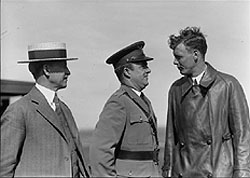
Courtesy of Library of Congress Prints and Photographs Division Washington, DC 20540 USA
Throughout human history, many people have challenged themselves and each other to see who could be the "best." Aviators are no exception. From the dawn of flight up to the present day, pilots have been a particularly competitive group as they vied to see who could fly the fastest, the highest, and the farthest. Many of them have also battled to see who could achieve an aviation "first." To non-pilots, some aviators' actions in pursuit of these goals may have seemed foolhardy, careless, or even crazy and needlessly reckless. But in reality, these aviators were actually pushing themselves in a courageous and determined manner to move beyond their supposed mental and physical limitations to conquer their many challenges.
Whether pursuing a flight record, performing aerial tricks in front of crowds, or exploring new areas of the globe, they shared some of the same fearless qualities. In all, the aerial explorers, daredevils, and record setters of the 20th century have been a very intrepid and driven group of individuals, determined to bring out not only the best in themselves, but also in each other.
In July 1909, Louis Bleriot, a French aircraft designer and self-trained pilot, became one of the first record setters in aviation history. On July 25, Bleriot, piloting a monoplane, braved strong winds and rain to become the first person to fly across the English Channel. Bleriot's 37-minute journey between France and England was the first major flight over a large body of water. It also inspired several adventurous individuals to become aviators, as well as helping to spark the public's interest in flight. When the first organized international air meet took place in Bleriot's native land only a month after his trip, somewhere between 300,000 to 500,000 spectators flocked to the event.
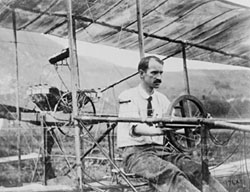
Courtesy of U.S. Centennial of Flight
The Reims Air Meet, which took place from August 22 to 29, 1909, in the Champagne region of France, was the world's first major aerial exhibition. Twenty-two aviators competed in a variety of contests and races. One of the contestants, Hubert Latham, who had unsuccessfully vied with Bleriot to become the first person to fly the English Channel, had better luck at Reims, when he won the altitude contest. The premier event of Reims was the 20-kilometer Gordon Bennett Cup Race, won by American airplane builder and pilot Glenn Curtiss, who beat Bleriot, the race favorite, and collected a $5000 purse as well as the title of "Champion Aviator of the World." As the first international air meet, Reims served as the model for all of the other organized contests that would soon follow, not only providing entertainment and the opportunity to set air records, but also offering a place to test the technological advances of aircraft.
In 1910, only a few months after Reims, three major air meets took place in the United States that drew many of the world's top aviators, among them Glenn Curtiss and Englishman Claude Grahame-White. Several aviation records were set at these meets, held in Los Angeles; Atlantic, Massachusetts near Boston; and at Belmont Park, New York. The meets also served to inspire future aviators, notably Lincoln Beachey and Harriet Quimby. Quimby was so thrilled by her experience that she instantly decided she wanted to learn to fly. Within a year, she became the first U.S. woman to earn a pilot's license. Quimby would go on to give several aerial demonstrations and help break down stereotypes that suggested that women could not make good pilots. Her ultimate achievement was when she became the first woman to cross the English Channel, on April 16, 1912, a feat also inspired by Bleriot's flight. Although Quimby had a major impact on women's roles in aviation, she did not live long. At the Third Annual Boston Aviation Meet in July 1912, the same meet that had enticed her to learn to fly two years earlier, Quimby died while demonstrating an aircraft.
Meanwhile, Curtiss, as well as history's first aviators--Orville and Wilbur Wright--were assembling their own teams of exhibition pilots. These teams traveled the country, entertaining crowds and helping to feed the public's interest and enthusiasm in flight by competing against each other to see who could fly the fastest, farthest, and highest. Curtiss team member Lincoln Beachey became the most accomplished and popular of all of the exhibition aviators. By the end of 1911, he was the single greatest moneymaker in aviation up to that time. During his career, he became the first to fly upside-down and the first American to "loop-the-loop." Unfortunately Beachey met the same fate as so many early exhibition pilots; he too, died while performing a stunt.
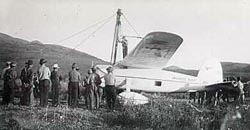
Photo used with permission of Acepilots.com, all rights reserved
Cal Rodgers, one of the Wright brothers' students, had learned to fly in June 1911 after only 90 minutes of flight lessons. Despite being deaf as the result of a childhood bout with scarlet fever, he established one of the first American aviation records. Starting from Sheepshead Bay, New York, on September 17, 1911, Rogers flew his Wright biplane flyer, the Vin Fiz, to California, landing in Pasadena, on November 5, and becoming the first person to fly across the United States, while setting the first major American aviation endurance and distance record.
Rodgers had carried the first transcontinental mail pouch on his cross-country trip, consequently joining the intrepid group of pioneering pilots that transported mail during aviation's first decades. Airmail pilots risked their lives delivering correspondence and packages across the nation and around the world while braving bad weather and difficult navigational challenges. Their efforts helped connect the United States and the world more quickly. Some well-known airmail pilots included Claude Grahame-White and even Charles Lindbergh, who would go on to have a major impact on aviation in the late 1920s.
After World War I, aerial daredevilry became more widespread thanks to the advent of "barnstorming." Stunt pilots and aerialists--or "barnstormers" as they became known, many of whom were former World War I pilots--performed almost any trick or feat with an airplane that people could imagine, often piloting their JN-4 "Jenny" biplanes, which the government sold cheaply as surplus. During the 1920s, barnstorming became one of the era's most popular forms of entertainment. For many pilots and stunt people, barnstorming provided an exciting and challenging way to make a living, as well as an outlet for their creativity and showmanship. The entire phenomenon seemed to be founded on bravado, with "one-upmanship" a major incentive. The fact, too, that there were no federal regulations governing aviation at the time allowed barnstorming to flourish during the postwar era.
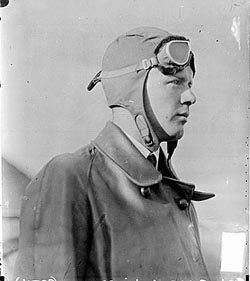
Photo from Library of Congress, Chicago Daily News negatives collection, n083854, Courtesy of the Chicago Historical Society
Several well-known aviators were barnstormers at one time or another. Charles Lindbergh, for example, learned to fly on the barnstorming circuit. He also did some wing walking and parachute stunting. Some other famous daredevils included Roscoe Turner (a future major speed racer), Bessie Coleman (the first licensed African American female pilot), Pancho Barnes, (born Florence Leontine Lowe who earned her nickname "Poncho" while working as a deck hand aboard a ship impounded by the Mexican authorities during the 1927 Cristero rebellion and would become a well-known speed queen of the "Golden Era of Airplane Racing"), Wiley Post, (a future holder of two trans-global speed records), Clyde "Upside Down" Pangborn" (who would set a major trans-Pacific flight record) and Ormer Locklear, (the first man to wing walk and Hollywood's first stunt flier).
After his days as a barnstormer and airmail pilot, Charles Lindbergh made history on May 20, 1927, when he became the first person to fly the Atlantic Ocean solo nonstop. Lindbergh's record-setting flight from New York to Paris, in the Spirit of St. Louis, a journey of 3,610 miles in 33 hours, became a major source of inspiration and a catalyst for many pilots who would later set their own significant aviation endurance and distance records.
Soon after Lindbergh crossed the Atlantic, other pilots looked to other oceans to traverse. The Pacific Ocean became the next logical and major challenge. Just a little more than a year after Lindbergh's flight, on June 10, 1928, Australian aviators Charles Kingsford-Smith ("Smithy") and Charles T. P. Ulm landed in Brisbane, Australia, having become the first pilots to fly across the Pacific. Their record-setting feat, like Lindbergh's, would inspire many aviators.
Jean Gardner Batten, a New Zealand woman, was one of the people particularly inspired by both Lindbergh and Smithy. Determined to become a record-setting aviator, she obtained her pilot's license in England, and soon after established a solo flight record, flying from England to Australia in 14 days, 22 hours, 30 minutes. The following year, on November 11, 1935, she set another record, the best flight time from England to South America. Braving extremely hazardous weather over the South Atlantic, Batten succeeded in flying the approximately 5,000 mile in just a little over 61 hours. Notably, Batten would go on to set several more aviation records during her career.
One of the pilots inspired to take action by Lindbergh's transatlantic flight was Douglas "Wrong Way" Corrigan, an Irish-American flier who incidentally had assembled the wings for Lindbergh's Spirit of St. Louis. Corrigan decided that he, too, was going to make his own transatlantic flight, and chose Ireland as his destination. Although federal authorities never granted him permission for a transatlantic flight because they considered his airplane too unstable, Corrigan defiantly flew to Ireland in July 1938 when he was "supposed" to be flying back to California. Corrigan gained his nickname by claiming that he had honestly flown the "wrong way" due to heavy fog and a faulty compass.
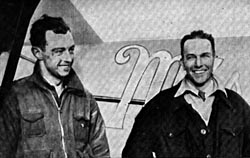
Photo from clipart.com
One of the most remarkable aviation endurance and distance records of the era was set by former barnstormer Wiley Post, the one-eyed son of a poor farmer, and Harold Garry, a well-known Australian pilot. The pair took off on June 23, 1931, from Roosevelt Field, Long Island, in pursuit of the current around the world record of 21 days held by the German dirigible, the Graf Zeppelin. Post and Gatty made it around the world in 8 days, 15 hours, 51 minutes. Approximately two years later, Post made the same flight solo, bettering his and Gatty's record by 21 hours.
Soon other aviators tried to surpass Post's record. Among these were former barnstormer Clyde "Upside-down" Pangborn and his navigator Hugh Herndon Jr., who had unsuccessfully raced against Post and Gatty in June 1931 in their attempt to better the Graf Zeppelin record. Pangborn and Herndon were actually doing quite well until they got lost over Mongolia and caught in a driving rainstorm. The pair settled on being the first aviators to fly nonstop from Japan to the United States, on October 4-5, 1931.
Howard Hughes, Jr., one of America's most famous billionaires and among the world's most important aviators, was determined to let nothing stop him in his pursuit of Post's global flight record. By the early 1930s, flying racing planes he had designed himself, Hughes had set several speed and altitude records. In 1936, he established several transcontinental flight records. Then, in July 1938, Hughes and a four-man crew took off from Floyd Bennett Field in Brooklyn and systematically set out to demolish Post's trans-global flight record. On July 14, he landed in front of some 25,000 cheering people in New York. Hughes and his crew had smashed Post's record, setting a record of 3 days, 9 hours, and 17 minutes, more than four days better than Post's mark.
Amelia Earhart was another pilot who attempted to set an around the world flight record. Earhart, inspired to take up flying after going to an early air show, earned her pilot's license in October 1922.
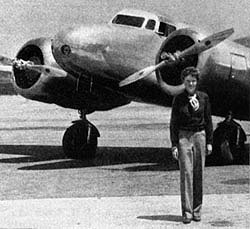
Photo of Amelia Earhart courtesy of Clipart.com
Soon after, she established the first of many altitude records. Over the next 15 years, Earhart would set several women's speed, altitude, and transcontinental records and also become the first woman to solo across the Pacific Ocean. Her ultimate goal was to be the first pilot of either gender to fly around the world at its widest point--close to the Equator. Earhart, one of the most accomplished pilots of either sex, set out on her journey on May 20, 1937. With roughly only 7,000 miles left to go, Earhart and her navigator Fred Noonan disappeared in bad weather near Howland Island in the Pacific. Search parties have never located Earhart, Noonan, or their plane.
While Earhart, Hughes, and others pushed themselves and their airplanes to their limits in pursuit of trans-global records, other intrepid aviators were testing their own limitations while exploring the harshest and most remote areas of the world, the polar regions. During the 1920s and 1930s, several aviators explored both the Arctic and Antarctic by air. Although some aerial explorers had used hot air balloons in the late 19th and early 20th centuries to venture into these areas, aviators did not conquer the Arctic until U.S. Navy Lieutenant Commander Richard Byrd and his pilot Floyd Bennett reached the North Pole via the skies on May 9, 1926. A few years later, in April 1928, Australian adventurer George Wilkins joined forces with a former Alaskan airmail pilot named Carl Ben Eielson to became the first humans to fly across the North Polar Sea. Then, on June 18, 1937, Russian pilot Valery Chkalov and two crew members improved on Wilkins and Eielson's record by setting a nonstop, long distance flight record when they flew the approximate 5,500 miles from Moscow to Vancouver, Washington, via the North Pole, in 62 hours. In the following years, several Russians would set other aerial records in the Arctic.
In December 1928, Wilkins and Eielson also became the first team of pilots to fly over Antarctica. Less than a year later, on November 28, 1929, Byrd established another polar first when he, pilot Bernt Balchen, and two other crew members were the first to fly over the South Pole. The last major Antarctic aviation "first" came when American explorer Lincoln Ellsworth and Canadian pilot Herbert Hollick-Kenyon became the first team to fly the width of the Antarctic continent from November through December 1935.
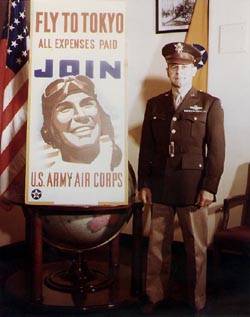
Photo courtesy U.S. Air Force Photograph
As aviators were exploring the most extreme reaches of the Earth during the 1920s and 1930s and setting records in the process, other pilots were establishing their own series of records at the major air racing trophy contests of the period. These contests produced arguably the most-exciting competitions in aviation history and contributed significantly to the advancement of aeronautics during what some historians have labeled "The Golden Age of Air Racing." Often, sponsored by wealthy benefactors, aviators competed at four major races during the era: the Pulitzer Trophy Race, a speed contest flown around a pylon-marked course; a seaplane race called the Schneider Cup; the Thompson Trophy, a closed circuit, pylon-marked contest, similar to the Pulitzer except that it was a mass start, free-for-all contest; and the Bendix Trophy Race, a transcontinental, point-to-point race. Many aeronautical innovations resulted because of these contests as engineers developed highly maneuverable aircraft that could race at breakneck speeds.
The major trophy races of the era produced several stars and record-setting performances. Jimmy Doolittle, a daredevil pilot and army man with a Ph.D. in aeronautical engineering, was one of the standouts of the era. Doolittle won the Schneider Cup in 1925 and then went on to capture the Bendix Trophy in 1931 and the Thompson race in 1932. He also established an aircraft speed record in September 1932 flying a Gee Bee racing plane. The Gee Bee racers, which several pilots flew to record-setting performances, were among the fastest and most controversial airplanes of the era, sporting the dubious reputation among some as "killers." Roscoe Turner, another former barnstormer and a Hollywood stunt pilot, also did extremely well in the major trophy races. The flamboyant Turner, who at one time carried a lion cub with him on his flights, won the Bendix Trophy in 1933 and three Thompson Trophies, a feat never matched by any other pilot. Turner also set seven transcontinental speed records during his career.
Several women also excelled in the air races of the 1920s and 1930s. Pancho Barnes, also a former barnstormer and Hollywood stunt pilot, competed in some of the women's air races of the period, including the Women's Air Derby (also known as the "Powder Puff Derby"). Barnes set several women's air speed records during her flying days.
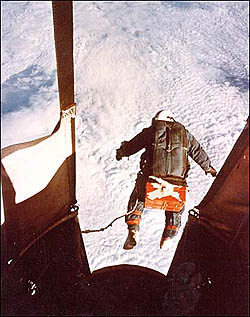
Photo courtesy of the U.S. Air Force
Louise Thaden was another woman who made significant showings in the trophy races. In 1936, Thaden and her copilot Blanche Noyes won the Bendix. Two years later, Jackie Cochran, arguably the greatest female aviator, won the same contest. Cochran, the president of the Ninety-Nines, an organization of female pilots who championed women's roles in aviation, set more speed and altitude records than any of her contemporaries, either male or female. During her career, she would receive more than 200 awards and trophies. Cochran not only became one of the world's great aviatrixes but also one of the best pilots of either gender. She would test and fly aircraft into the 1960s and become the first woman to break Mach 1, or the sound barrier.
The first person to fly faster than the speed of sound, however, was Cochran's good friend Chuck Yeager. On October 14, 1947, Yeager exceeded Mach 1 in the X-1, an experimental aircraft. Yeager is undoubtedly the world's most famous test pilot and one of the "toughest" fliers, both mentally and physically. During his career in the U.S. Air Force, he not only established multiple flight records but also displayed extraordinary courage and determination.
Joseph Kittinger was another U.S. Air Force officer who demonstrated outstanding bravery and established several records. On June 2, 1957, Kittinger became the first person to ascend to over 96,000 feet (29,261 meters) in a balloon. Two years later, on November 16, 1959, he became the first individual to parachute back to Earth from a high altitude when he jumped from a height of 76,000 feet (23,165 meters). Within a year, he would go on to establish several more high-altitude records and free-fall marks while challenging many people's ideas about the limits of human beings and helping prepare the country for the human spaceflight program.
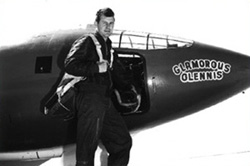
Chuck Yeager photo courtesy Air Force Test Center
In December 1986, Dick Rutan and Jeana Yeager, two pilots who embody much of the same spirit, character, adventure, and heroism as Kittinger and Chuck Yeager (although Jeana is not related to the test pilot), broke one of aviation's last record barriers when they flew nonstop around the globe in their plane, the Voyager. Taking nine days, three minutes, and 44 seconds they traveled 24,986 miles and established a nonstop global record. They also endured the longest flight up to that point and almost doubled the then current flight distance record. Rutan and Yeager's flight explored the limits of human endurance and mental fatigue and represented the triumph of the human spirit.
From Louis Bleriot to Dick Rutan and Jeana Yeager, aviators have pushed themselves and their aircraft in their quest to be the "best." Many aerial explorers, daredevils, and record setters spurred each other on and motivated others to follow in their flight paths. With their competitive natures, aerial explorers, daredevils, and records setters all shared a little bit of the same traits. In many ways, each had to be part explorer, daredevil and records setter and willing to explore their own personal limits and the limits of their machines in a very brave and determined manner.
This essay is taken from Explores, Daredevils, and Record Setters-an Overview by David H. Onkst. The original essay can be found at the U.S. Centennial of Flight's website.
Visit the National Park Service Travel American Aviation to learn more about Aviation related Historic Sites.
Last updated: April 9, 2019
